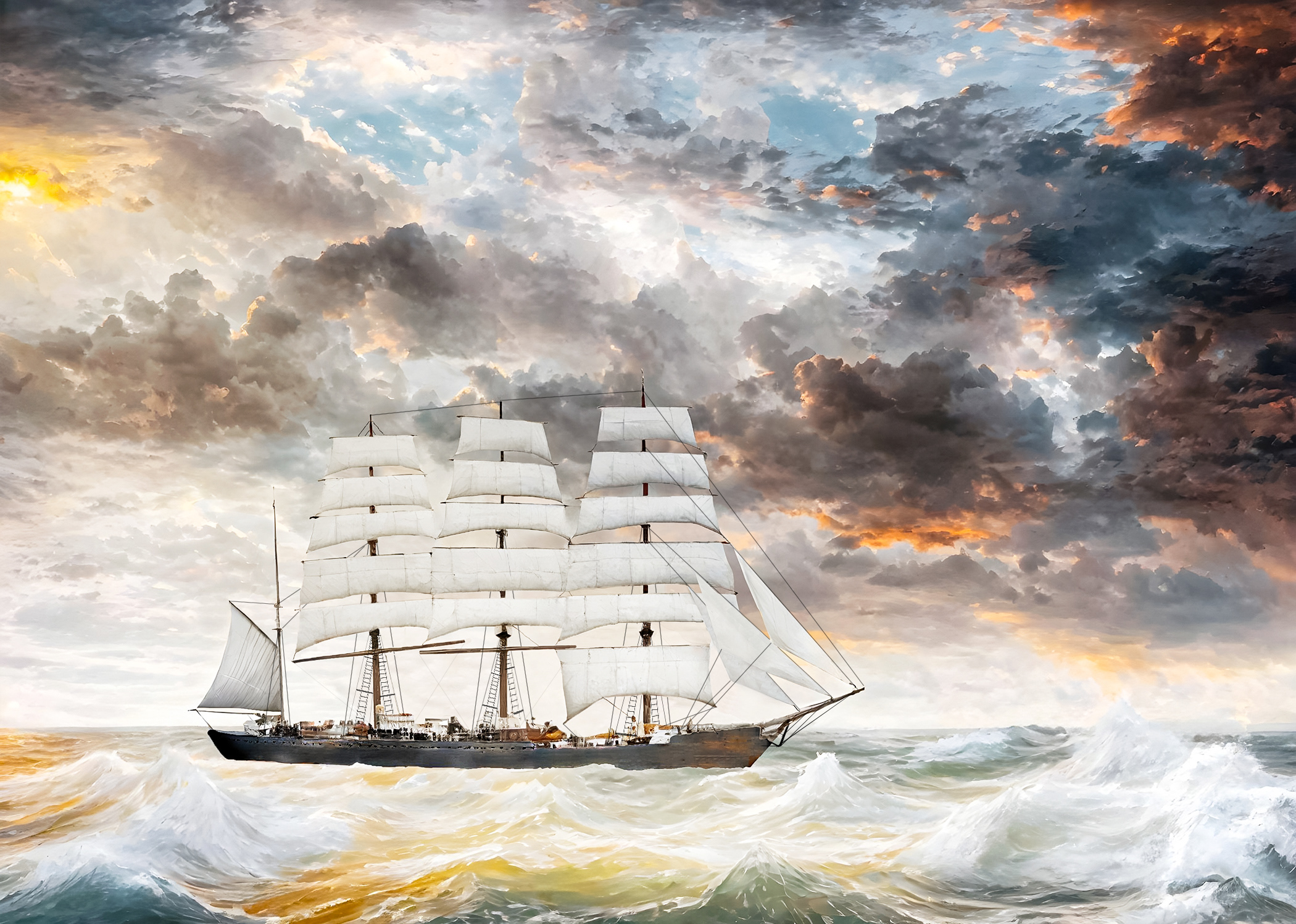
Dirigo
2024
Dirigo, the Latin word meaning “I direct” or “I lead,” serves as both the motto of the state of Maine and a fitting name for a vessel of significance in American maritime history. The steel sailing ship Dirigo, constructed in 1894 by Arthur Sewall & Co. of Bath, Maine, marked a pivotal moment in the evolution of shipbuilding in the United States: she was the first steel-hulled sailing vessel built in the nation, a bold departure from the centuries-long tradition of timbered construction that had shaped both the physical and cultural identity of American seafaring.
The Sewall shipyard was the most successful shipbuilding firm in Bath for several decades, building more than one hundred merchant ships, mostly deepwater square-riggers and the only American yard of its time to pivot successfully from wooden sailing vessels to steel. Measuring 3,005 gross tons and extending 312 feet in registered length, she belonged to the last great generation of deepwater square-riggers.
In 1912, Dirigo undertook a remarkable voyage: a 14,000-mile passage from Baltimore to Seattle, carrying 4,576 tons of coal, with the American writer Jack London aboard, accompanied by his wife, Charmian London, and their Japanese servant. What renders this episode especially curious is the mingling of labor and literature: London, a man who had long romanticized the sea, shipped as mate, while Charmian served as stewardess, a gesture as much performative as practical. The image of London climbing ratlines and scrubbing decks while also carrying typewriters and a trunk full of paper for his craft—seeking to change physical toil into literary capital—captures the tension at the heart of his work: between action and narration, immediacy and recollection.
From this voyage, London drew the imaginative material for his 1914 novel The Mutiny of the Elsinore, a work haunted by the specter of disintegration: of authority, of social order, and of the very maritime culture that had sustained so many of his earlier narratives. The voyage of the Dirigo thus becomes not merely an historical footnote but a pivotal inflection point in the symbolic economy of early twentieth-century American letters.
After Sewall sold the Dirigo to San Francisco owners in 1915 her fate was sealed by the geopolitical upheavals of the First World War. In 1917, she was sunk off the Irish coast by a German submarine, her destruction an instance of the broader annihilation of the world of commercial sail by the relentless forces of modern mechanized increase. The Dirigo was a vessel navigating between the age of sail and the age of iron, between the realm of mythic seafaring and the sober, often brutal realities of increase.

White Falcon
2025
White Falcon, a clipper ship, was built in Pittston, Maine 1853. The following is condensed from an article in The Daily Mirror August 8, 1949.
During June 1857, the American clipper White Falcon—proudly sweeping before a moderate gale some 400 miles east of Manila—concealed beneath her full canvas a cargo of human misery rather than noble freight. Ostensibly bound from China to Callao, she had embarked roughly six hundred Chinese “coolies,” recruited through a mixture of deceit, official compulsion, and outright kidnapping, destined for indentured servitude in the guano quarries of Peru’s remote Chincha Islands.
In the wake of the abolition of the transatlantic African slave trade, colonial powers had instituted “indenture” as a legal veneer, prescribing modest wages, regulated accommodations, and medical oversight. Yet these safeguards were routinely flouted: shipowners, unwilling to forfeit profit, packed far beyond licensed quotas, eliminated surgical staff to cut costs, and, when faced with inspection, jettisoned dozens of captives to lighten the ship. Mortality on the sixty-day Pacific passage often approached thirty per cent, as dysentery, typhus, suffocation, and internecine violence claimed hundreds.
Upon arrival at Callao, the survivors—valued at £25 each—were dispatched to the Chincha Islands, where guano deposits, centuries-accumulated seabird excrement, were laboriously extracted. Under contractors’ penny-ante returns of three to four shillings per ton, overseers met profit-driven quotas by driving coolies naked in loincloths to dig six to eight tons daily, seven days a week. Punishments for the slightest infraction ranged from floggings with barbed whips to prolonged suspension in chains under the tropical sun, or half-drowning tethered to barnacled buoys. Mortality on the islands was so extreme that fresh human cargoes were shipped continuously to replace those who perished.
Three days out from Manila, as the White Falcon rolled under fair skies, the captain ordered the hatch gratings removed for air. Seizing the moment, a faction of captives surged upward, their cries echoing like a rebellion born of desperation. In panic, the Portuguese skipper drew pistols and fired into the heaving mass, slaughtering dozens. The dead formed a macabre barricade; sparks from gunfire ignited cotton garments, and, amid fetid confines, captives fanned rags and religious joss paper into flame.
Belowdecks, the conflagration spread unchecked despite the crew’s hoses; as smoke choked the hold and heat ignited the decks above, the captain refused to release the captive multitude, fearing to be overwhelmed. After half an hour of agonized screams, silence fell. With the ship’s integrity fatally compromised, the crew hastily launched three overcrowded boats—one capsized and its ten occupants drowned. The longboat, scarcely provisioned, towed its consorts back to Manila, where survivors’ testimonies, elicited aboard H.M. Gunboat Rattlesnake, revealed the full atrocity.

Flying Scud
2024
An extreme clipper ship, she was built and launched in 1853 by Metcalf & Norris, Damariscotta, Maine. An extreme clipper ship was designed to sacrifice cargo capacity for speed. They had a bow lengthened above the water - a drawing out and sharpening of the hull. In the United States, extreme clippers were built in the period 1845 to 1855. Extreme clippers remained in vogue only a few years because their design lacked structural integrity.
Scud refers to moving fast in a straight line as if driven by the wind. Flying Scud was considered one of the fastest clippers ever built.
In spring 1861, sailing from Whampoa to New York she was struck by a whirlwind which carried away all three topgallant masts and many of her 17 sails. She was struck by lightning twice, but ship was not materially damaged.
In late fall 1861 one eighth share of the ship was sold for $3500, valuing her at $28,000. She was initially purchased for $100,000 seven years earlier.
She was sold to British interests in April 1863 and renamed Cestrian. She went into the England-India service, but not before being captured by Union forces suspected of blockade running cotton.

Red Jacket
2024
Red Jacket was a clipper ship, one of the largest and fastest ever built. She was also the first ship of the White Star Line company. She was named after Sagoyewatha, a famous Seneca Indian chief, called "Red Jacket" by settlers. She was designed by Samuel Hartt Pook, built by George Thomas in Rockland, Maine, and launched in 1853, the last ship to be launched from this yard.
In 1872 Red Jacket became a lumber carrier from Quebec to London, joining the clippers Marco Polo and Donald McKay, which ended their days in the transatlantic Quebec timber trade. She collided with and sank the Eliza Walker in 1878. On 29 January 1878, she put in to Boston in a leaky condition, her crew refusing to proceed. In 1882, she dragged her anchors in a heavy gale whilst on a voyage from Lisbon to Casablanca and ran aground near Soria Kedima. The sale of her wreckage fetched just £113 and completely disappeared by 1907. - Wikipedia
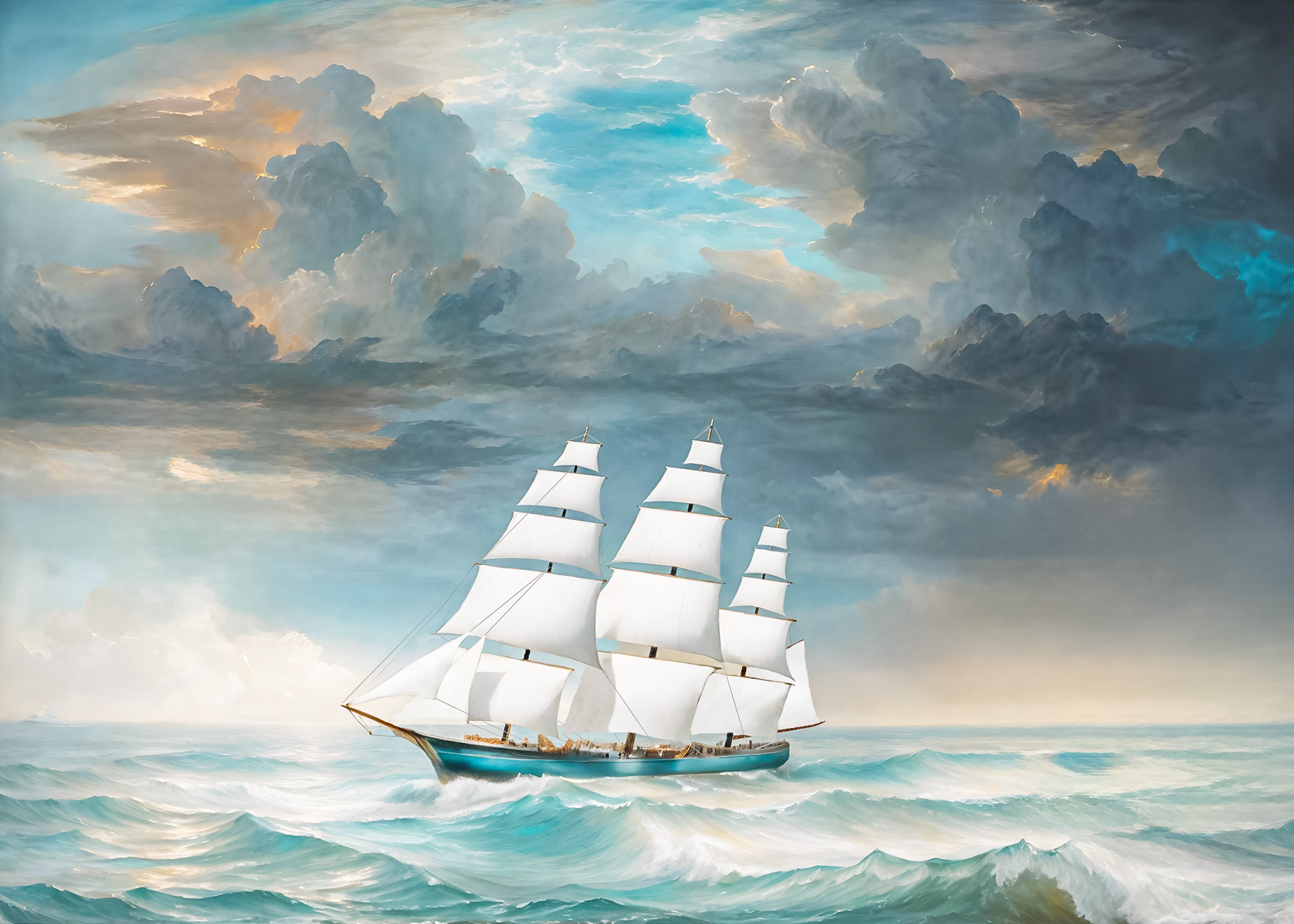
Snow Squall
2024
Built in South Portland in 1851, Snow Squall holds the record for the fastest round trip between New York and Rio de Janeiro at 53 days.
Snow Squall was an extreme clipper ship built for the China trade. She was built for speed with a sharp, narrow hull, and an enormous amount of sail. She was launched by Cornelius Butler at Turner's Island and purchased by Charles R. Green of New York for $30,410.
In March 1864, Snow Squall ran aground in the Straits of Le Marie, a strait between Isla de los Estados and the Argentine portion of Tierra del Fuego. She was moved to Port Stanley in the Falkland Islands, a 365 mile distance. In July, she was found damaged beyond repair, condemned, and sold - seven years short of her 20-year expected useful life.
In 1979 she was rediscovered in the Falklands, and in 1982 a 32-foot portion of her bow and other remains were returned to Maine. Since 1995 the bow resides at the Maine Maritime Museum, Bath, Maine. It remains a solitary reminder of American-built clipper ships.
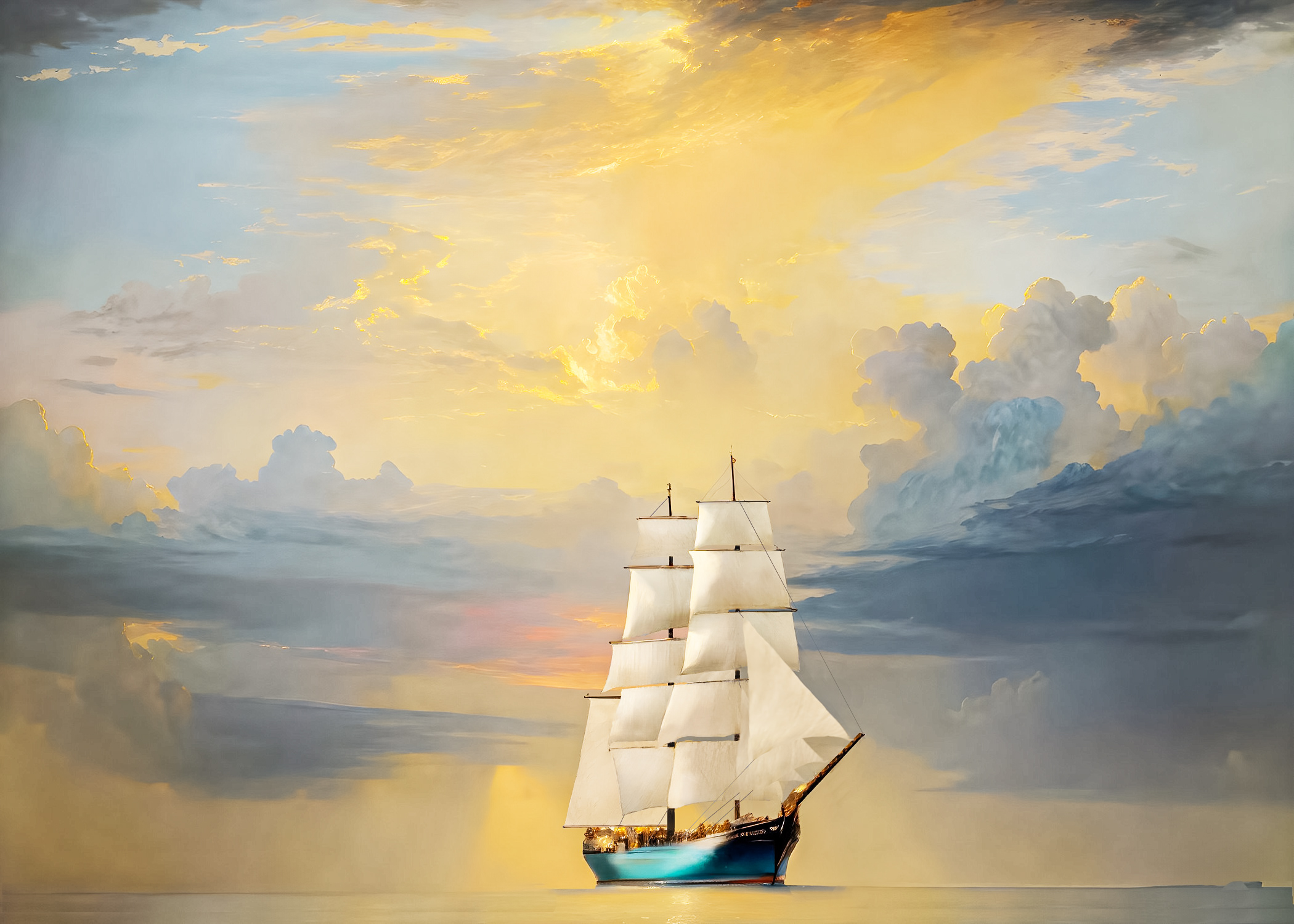
Brig
2024
A brig was a fast and maneuverable vessel with two square-rigged masts. It was used as both naval warships and merchant vessels. A brig was generally built on a larger scale than the schooner, and varied in length between 75 feet and 165 feet. A brig made of pine in the 19th century was designed to last for about twenty years.
In the early 19th century the brig was a standard cargo ship. It was seen as fast and well sailing, but required a large crew to handle its rigging. Brigs could not sail into the wind as easily as fore-and-aft-rigged vessels such as schooners, but had the advantage when travelling offshore in the trade winds where vessels sailed downwind for extended distances.
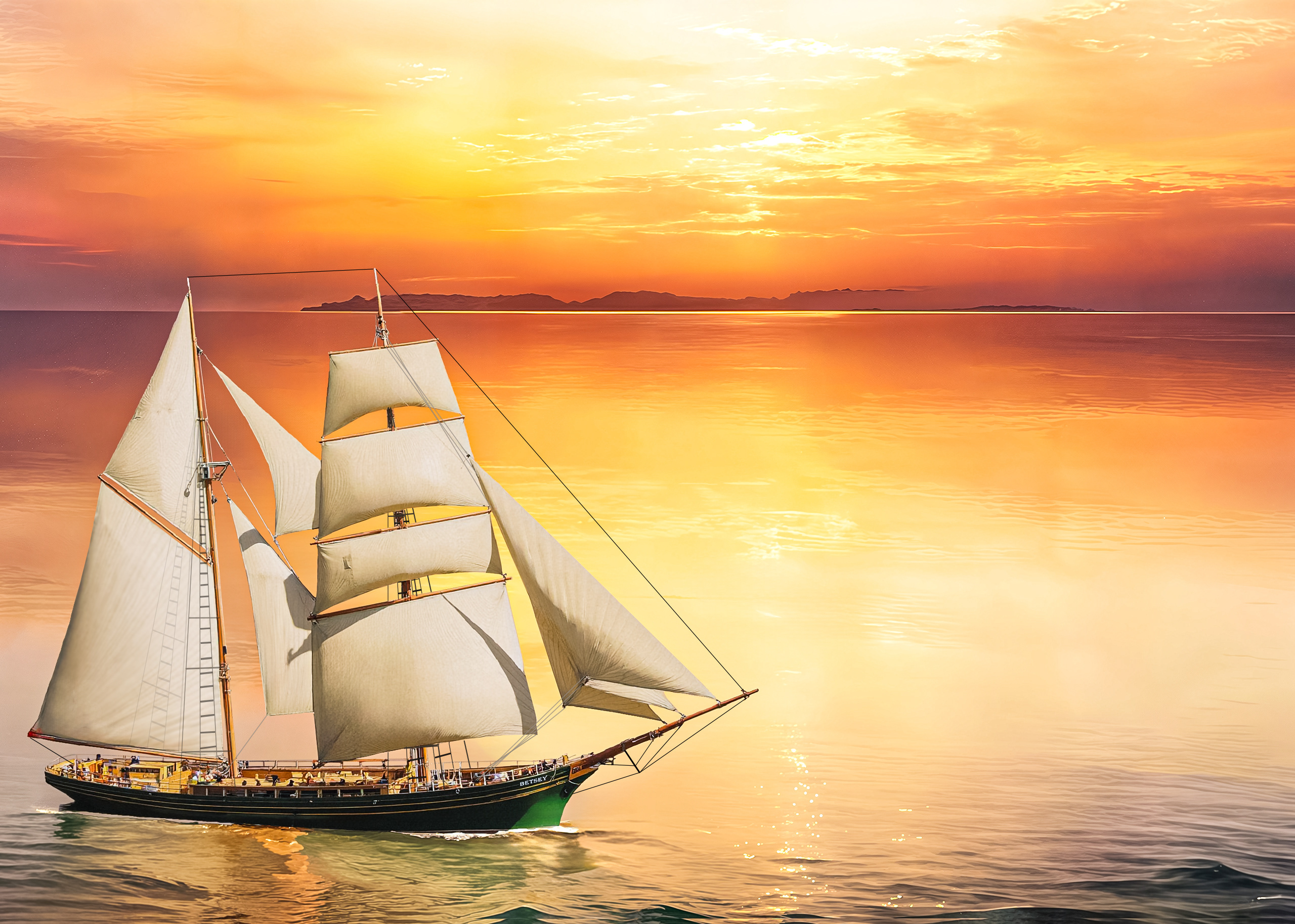
The Betsey
2024
The Betsey was built on the Sheepscot River in Wiscasset Massachusetts in 1803 – now midcoastal Maine. The Betsey was a hermaphrodite brig, or brigantine. A standard brig has a square rig on both the foremast and mainmast. A hermaphrodite brig has a fore-and-aft gaff-rig or schooner mainsail
The Betsey’s lot in life was to sail from Wiscasset to the West Indies with lumber and return with molasses, sugar, and coffee. Ships that sailed this route were known as West Indiamen, even though ships were referred to as “she.”
Scarcely three weeks into her voyage of 1824, on the night of December 19, and less than a day’s sail from its Matanzas, Cuba destination, the vessel succumbed to the wrath of a sudden northerly gale.
Against insurmountable odds, the surviving mariners clambered into the Betsey’s longboat and, amid driving rain and mountainous seas, reached a nameless isle—later charted as Cruz del Padre. Their relief, however, proved tragically fleeting: the fishermen whose aid had been eagerly solicited, betrayed the shipwrecked party into the hands of marauding pirates. In the ensuing carnage, only two survived, one being first mate, Daniel Collins of Wiscasset.
Collins’s return to his native Maine was shadowed by the horrors he had witnessed; henceforth, he vowed never again to set foot upon a vessel. He spent the final eight decades of his life on land, sustained by the memories of loss and survival, until his death on November 15, 1885, at the age of eighty-four.
A passage from Daniel Collins’s book dictated to newspaper editor John Dorr, the year of his return:
“On the 18th of December we passed the Berry Islands, and early next morning came to anchor within a league of Orange Key, on the Bahama Banks. It was the morning of the Sabbath, so calm and clear that even the lengthened billows of the Gulf Stream seemed sleeping around us, and the most untutored son of Neptune could not but remember that it was a holy day, consecrated to devotion and rest. Here we continued until noon, when a fresh breeze from the North invited us to weigh anchor and unfurl our sails, which, swelling with a fair wind, were as buoyant as our own spirits, at the increasing prospect of reaching our port of destination.”
Full text available at Project Gutenberg under the title: NARRATIVE OF THE SHIPWRECK OF THE BRIG BETSEY,
OF WISCASSET, (MAINE,)AND MURDER OF FIVE OF HER CREW, BY PIRATES, ON THE COAST OF CUBA, DEC. 1824.
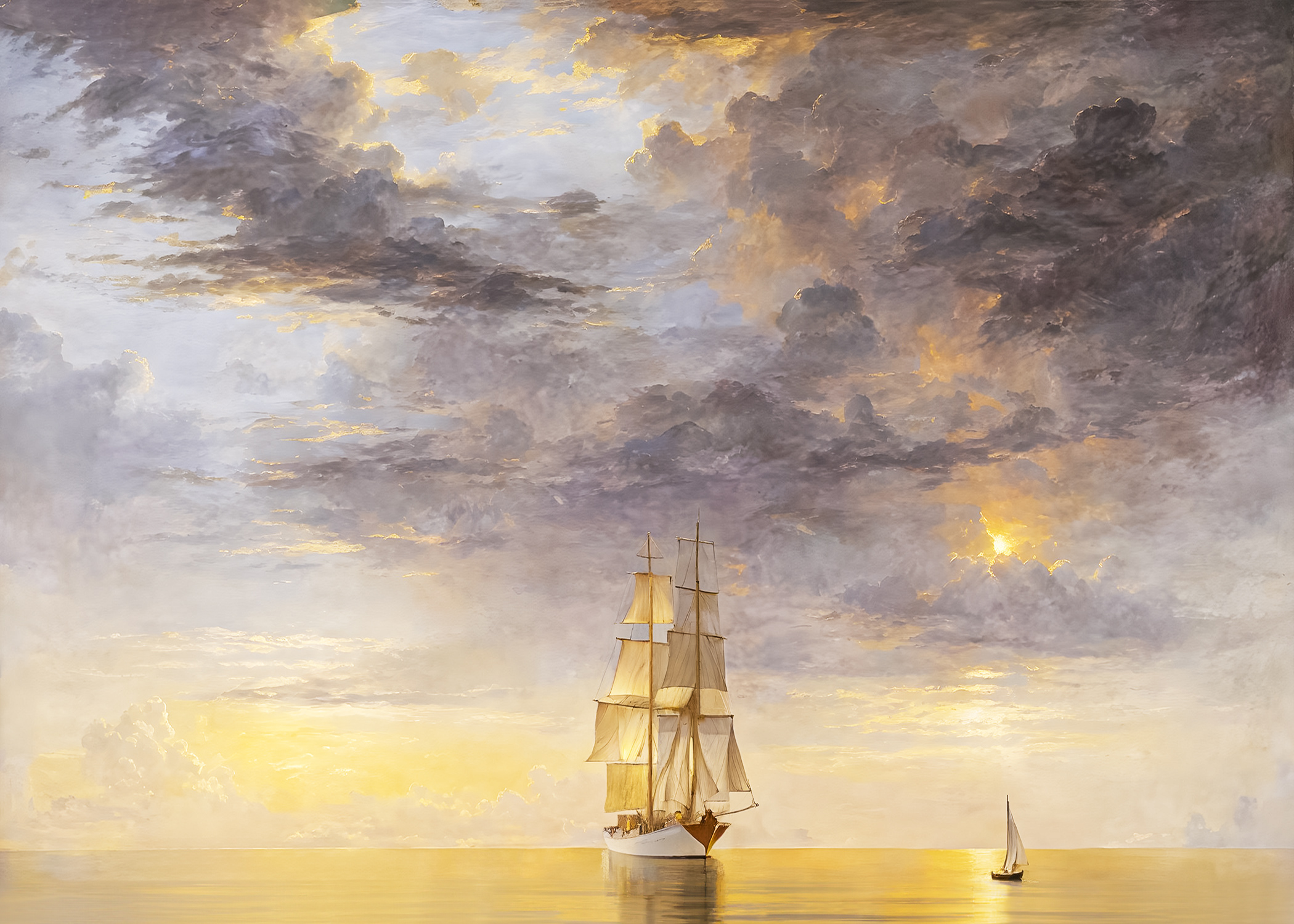
The Brig Portland
2024
The Brig Portland was built at Boothbay, Maine, in 1854. She was 107 feet long and registered 299 tons. She was originally owned in Wiscasset, ME, but later hailed from Boston, Massachusetts. Her Captain Robert Montgomery and Arthur Portland were the principal owners. It is claimed on her first voyage to Liverpool, England that she paid for herself and made a profit of $40,000. On December 31, 1862 she sailed from Boston to Australia and was never heard from afterward.
A brig is a type of sailing vessel defined by its rig: two masts which are both square-rigged with an additional gaff-rigged spanker behind the mainsail.
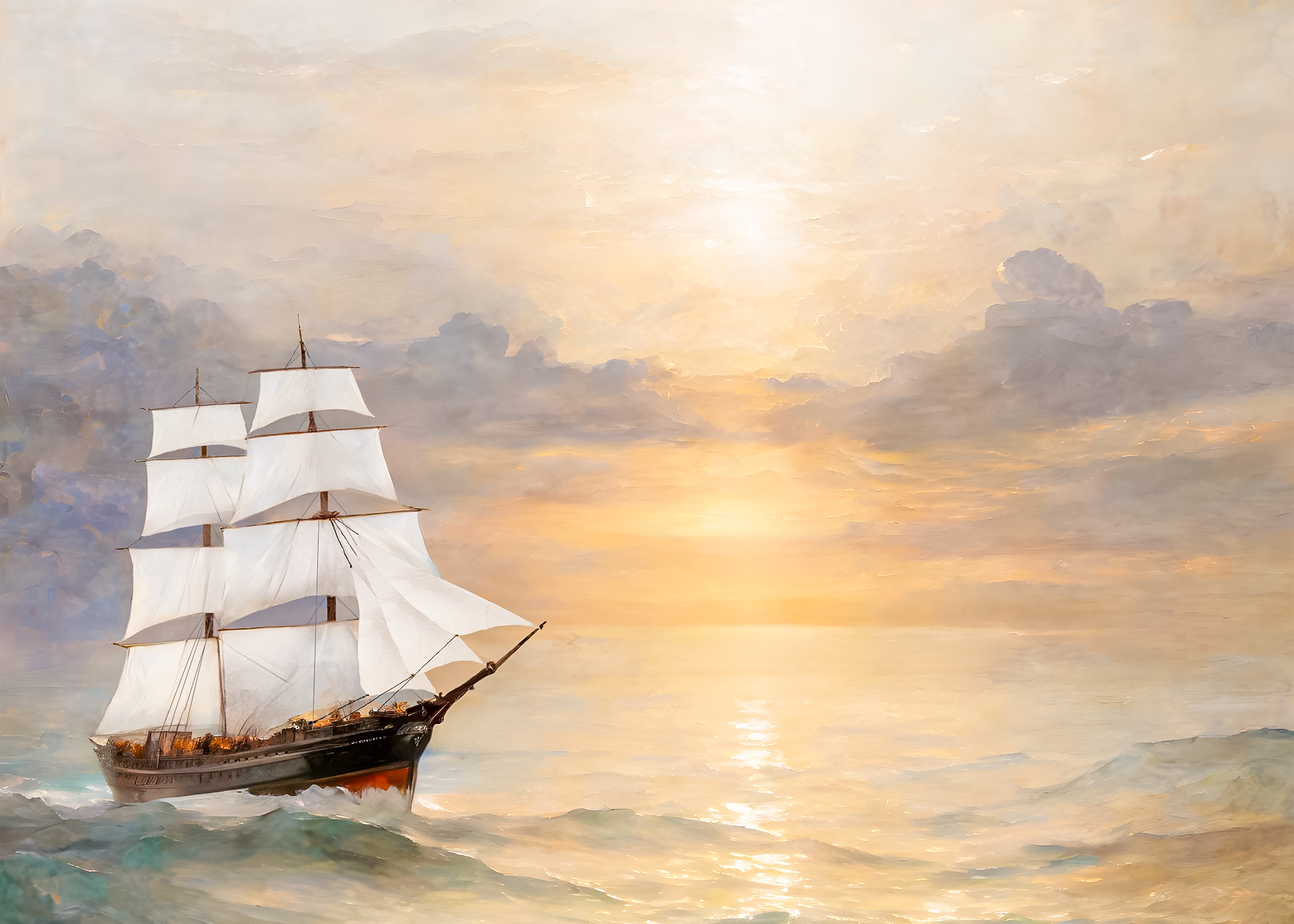
The Telos
2024
The Telos was built in Bangor, Maine in 1883. She was reportedly the last brig to join the American merchant marine. After the Civil War, the brig was rapidly replaced by the more economical schooner; by 1882 about 260 brigs remained under American registry. Of these, about 150 were Maine-built, and ninety were registered to Maine ports.
The Telos was considered to be the finest vessel of her class ever constructed in Maine. She was wrecked on Aves Island in the Caribbean in 1900. The crew was saved and landed in La Guayra, Colombia.

Aryan
2024
Aryan was the last wooden full-rigged ship built in the U.S. for commercial purposes. She was built in 1893 at the shipyard of C. V. Minott Kennebec River, Phippsburg, Sagadahoc County, ME. She carried cargoes mostly between New York and West Coast ports, traveling around Cape Horn. She was re-rigged to a barque and plans were made to make her a 5 masted barquentine.
During December 24, 1918 on voyage from Wellington, New Zealand to San Francisco she caught fire between decks. The crew abandoned their burning ship in two boats 300 miles east of Chatham Islands. One boat carrying 12 people reached the Chatham Islands. The other boat was still missing on December 30th, whilst a storm was raging in the area.

MARY JANE
2024
Capt. Josiah Remick first built the schooner Mary and then the schooner Jane. He finally built a brig which he named the Mary Jane. All were named for his daughter Mary Jane, born in 1797.
Under the cover of every fog, hundreds of barrels were smuggled between Canada and the Maine coast during the Embargo of 1807. The Mary Jane, laden with contraband, was intercepted by a cutter dispatched to halt its escape from Bath. Despite the cutter's attempt to block it, the Mary Jane escaped, exchanging gunfire before disappearing downriver.
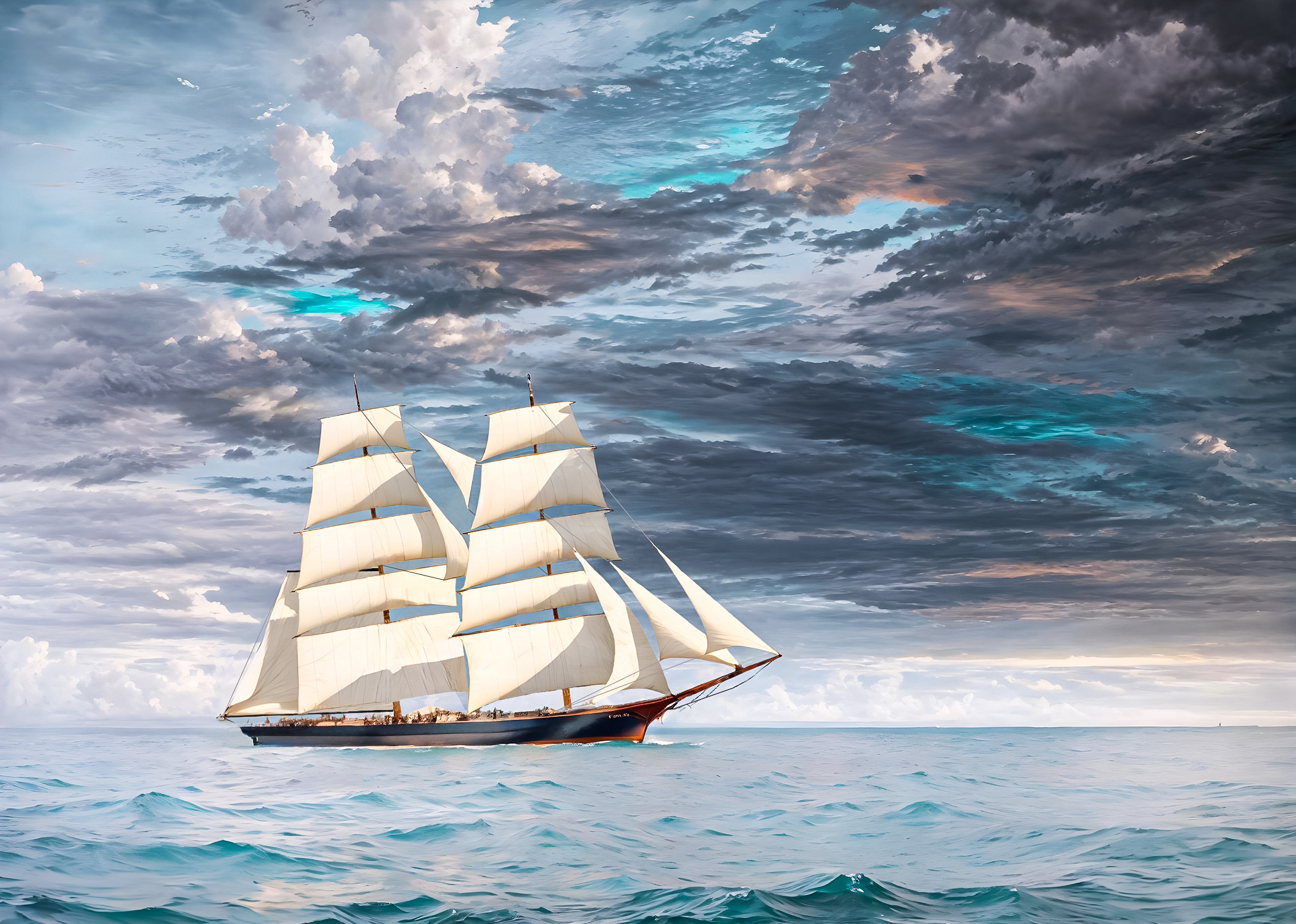
Joseph
2024
The brig Joseph was built in Brewster Maine in 1794 and launched in the Piscataqua river which forms a boundary between Maine and its southern and western neighbor New Hampshire.
The ship saw lots of action during its life. In June of 1795 during an inspection off Halifax, in a fistfight with an officer of the English sloop of war Rattlesnake the captain of the Josph bested the Englishman. The Joseph was captured by the British in 1811.
On November 30, 1818 in one of the small harbors in the West Indies, the Joseph was boarded by pirates who killed a visitor with a pistol. After ransacking the vessel, Augustus Sheafe of Portsmouth was forced to accompany the pirates on a marauding party.
Sold to foreign interests in 1834 – fate unknown.
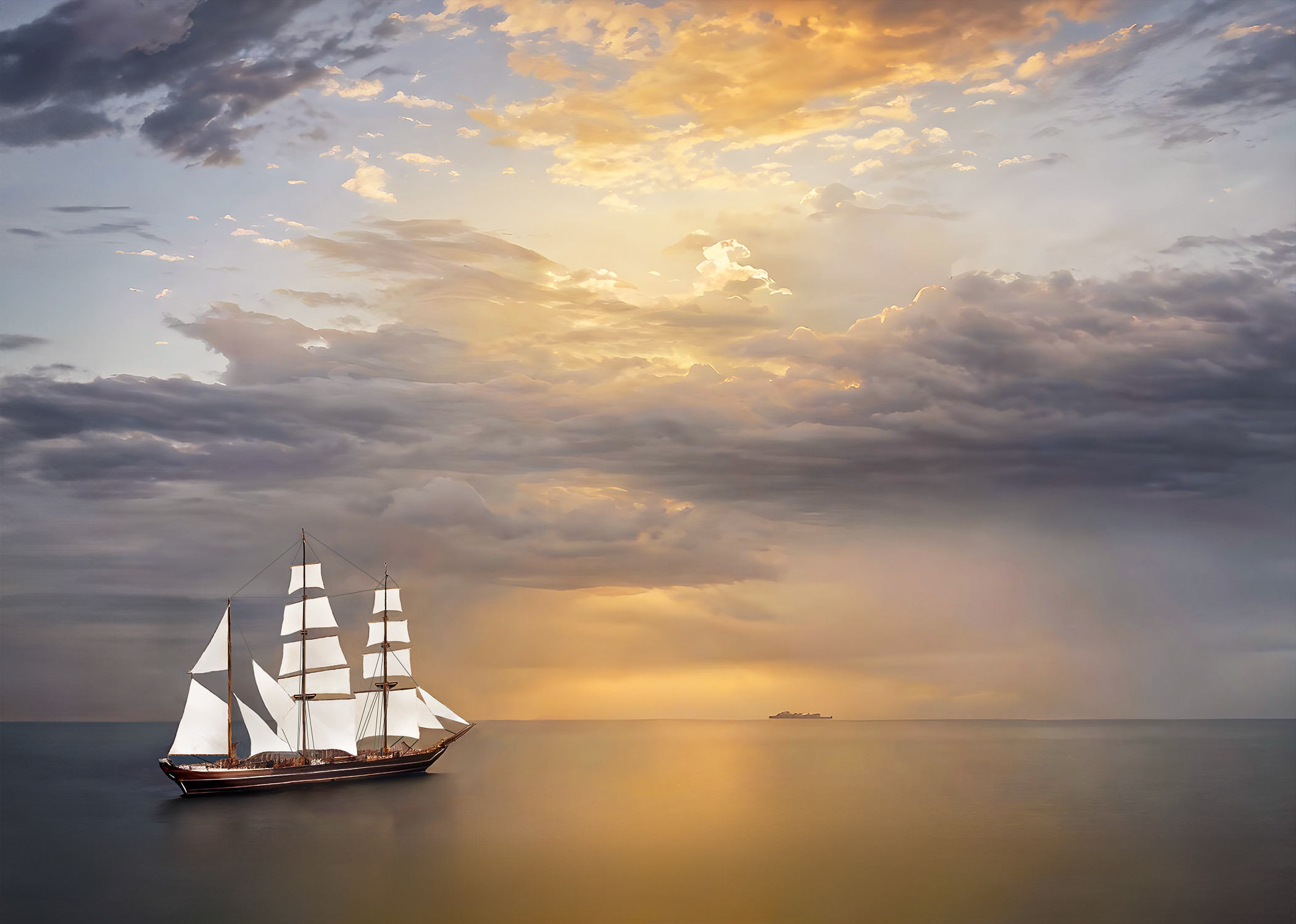
General Grant
2024
The barque General Grant is in irons with an island in the distance.
The ship departed Melbourne on 4 May 1866 bound for London via Cape Horn, under the command of Captain William H. Loughlin.
At 11pm on 13 May 1866, the Auckland Islands were sighted dead ahead. With only light winds, the crew were unable to change course, and eventually collided against the cliffs and drifted into a large cave on Auckland Island's western shore. The rising tide and increasing swell caused the main mast to hit the cave roof repeatedly until the mast forced a hole through the hull; the ship sank on 14 May 1866. Although the weather remained calm, the boats were not launched immediately on the ship entering the cave as it was very dark, there was no obvious landing place, and pieces of spars and rock were falling continually.

Ocean King
2024
Per the Kennebunkport Historical Society:
Launched October 6, 1874 the Ocean King was a 4-masted bark. She was built by Master Carpenter Benjamin Jackson at the N.L. Thompson shipyard in Lower Village Kennebunkport, Maine.
She was owned by the J. Henry Sears & Co., Boston, MA from 1875-1883. Employed in the New York - San Francisco - Liverpool route she travelled around the horn and back several times. When J. Henry Sears & Co., went out of business in 1883 she was laid up at San Francisco for 3 years.
May 8, 1887, the Ocean King Sprung a leak in the North Pacific and had to be abandoned when the steam pump failed. The crew was taken off the sinking ship by the schooner Angel Dolly.

Snow & Burgess
2025
Snow & Burgess started as a Three-Masted Ship launched in 1878 from Thomaston, Maine. She was 228.5 feet l°ng by 41.5 feet wide and 24.7 feet in depth, and had a gross tonnage of 1655.49. San Francisco's Captain A. P. Lorentzen bought her in 1900 and a year later she was converted by Boole's shipyard in Oakland to the five-masted schooner. On 5 Sept. 1902, Capt. A. H. Sorensen of the five-masted schooner Snow & Burgess and his wife Marie welcomed a baby girl while at sea. In 1990, Burgess Cogill (nee Sorensen) published When God was an atheist sailor: Memories of a childhood at sea, 1902-1910.

Schooner
2024
What type of ship did pirates prefer?
A fast ship with a shallow draft enabled the pirates to hide in relative safety in shallower waters where larger warships could not enter. Because of its size and maneuverability, a schooner was one of the pirate's favorites.
Schooners were very fast with a narrow hull. A schooner could reach up to 11 knots in the right conditions, carried up to 75 crewmen and had 8-12 guns. All those features enabled the pirates to navigate easily in shallow waters and shoals, allowing them quick escape or to attack suddenly. They were usually two-masted and all masts were fore-and-aft rigged.

Addie M. Lawrence
2024
Built in 1903 by Percy & Small in Bath for J. S. Winslow Corp. In 1917 sold to the France & Canada Steamship Co. In July of that same year, she was wrecked at the entrance of River Loire near St. Nazaire, Brittany on voyage from Boston with general cargo.
Schooners were designed and built for coastal trades, but some of them made longer, foreign voyages, especially during World War I. Ten 6-masters were launched in Maine. Awkward to handle in confined waters, deficient in longitudinal strength, and the sheer size of the huge gaff sails made the failure of the donkey engine inevitable.

Bertha L. Downs
2024
The North American schooner Bertha L. Downs was one of many large four, five and six-masted schooners which were built on the banks of the Kennebeck River at the end of the 19th and the beginning of the 20th centuries. These huge wooden vessels were employed in the coastal trade and the principal part of this was coal from Virginia to New England. She was launched in 1908 and, after some ten years in the lumber and coal trade, was sold to Danish owners and renamed "Atlas". Like several of her contemporaries, she was able to make a profitable living through the 1920s and 30s. She was finally broken up in Germany after 42 years of work under five flags.
The Schooner Bertha L. Downs (Anatomy of the Ship) Greenhill, Basil Published by Conway Maritime Press (1999)
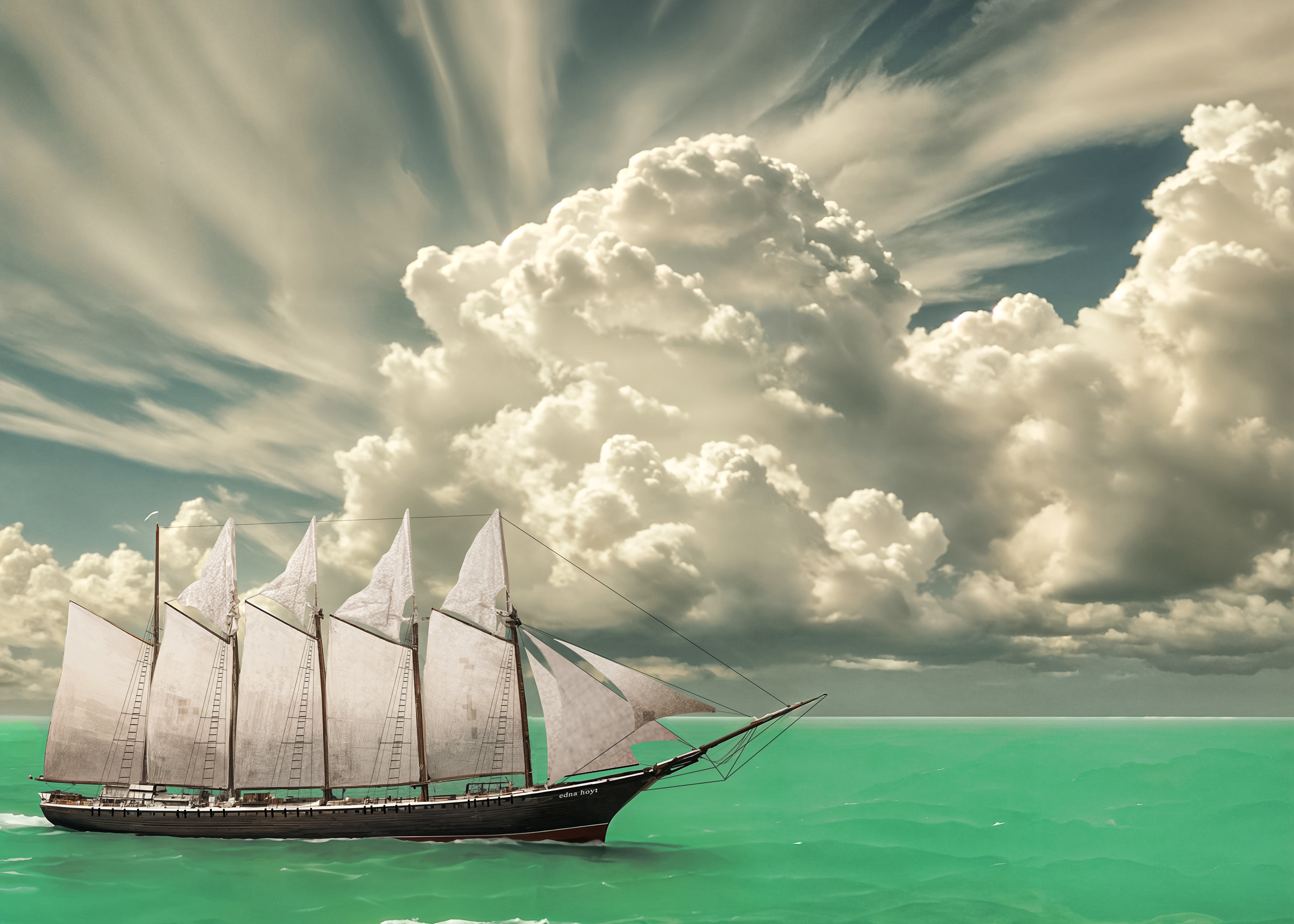
Edna Hoyt
2025
Last of the 52 five-masters built in Maine from 1888 to 1920. Built by Dunn and Elliot, Thomaston, Maine for account of the Superior Trading and Transportation Company. Named for the wife of one of its investors and built at a cost of $280,000.
Coast Guard captain W. J. Lewis Parker wrote in a 1948 study: “built and officered by local men, managed by a leading citizen, and owned by the builder, the captain, the sailmaker, the doctor, and a score of other substantial townspeople.’’
Built by Dunn and Elliot, Thomaston, Maine for account of the Superior Trading and Transportation Company. Named for the wife of one of its investors and built at a cost of $280,000.
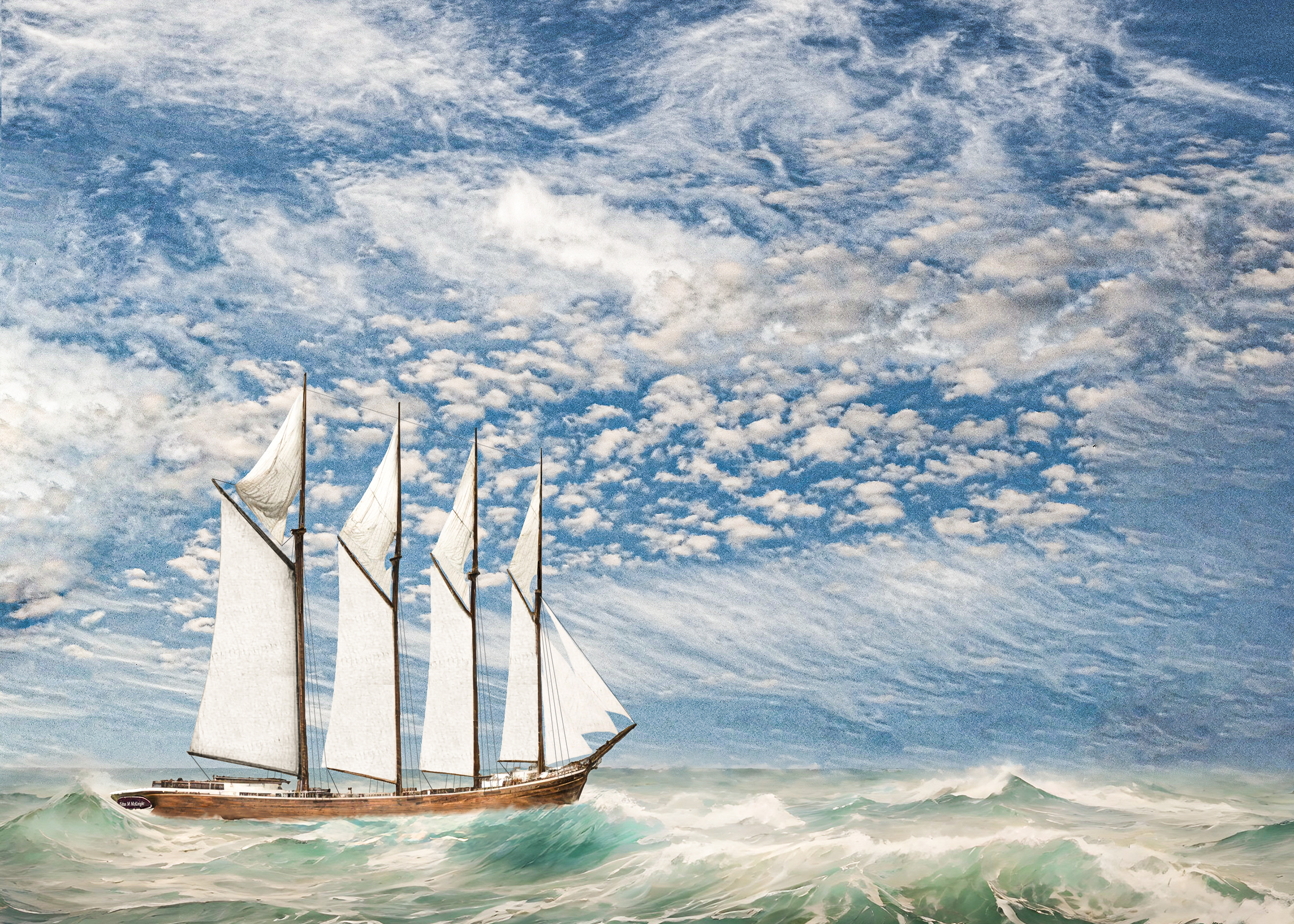
Edna M. McKnight
2025
Edna M. McKnight was famous for being known among the Mill Cove relics as “the one without masts.” A four-master built at the Camden shipyard of Robert L. Bean. The yard was closed in 1909 when Robert’s father Holly Bean retired. Robert reopened the yard and started from scratch in 1916. He completed 12 ships by the closure in 1920. Eleven 11 of the 12 resulted in a disaster designation per the International Maritime Library.
Edna M. McKnight was the third largest that Bean built. A collier or bulk carrier a cargo ship designed to carry coal. Her net tonnage, the space or volume available for cargo, was 1203.
She met her end in 1926, when she was de-masted by a powerful storm off the Virginia coast while heavily loaded with lumber. Her crew was taken off by a passing steamer on 7 December; the hulk was allowed to drift off.
On the 28th of the month she was relocated, and tug dispatched to bring her into Bermuda. By September of the next year the hulk had reached Boothbay Harbor for repairs. However, she was judged not worth repairing and was cast away to rot in Mill Cove.

Eleanor A Percy
2024
The 6 masted schooner Eleanor A Percy was launched from the Percy and Small shipyard in Bath on October 10, 1900. At the time of her launch, she was the largest sailing vessel in the world and the 2nd ‘6 master’ to be launched from Percy & Small. On her second voyage, as she was inbounding to Boston loaded with over 5000 tons of coal, she struck a ledge near Boston Light. In June of 1903 off Cape Cod she hit the George Wells, the only other 6 masted schooner in the world.
She left Rio de Janeiro on November 11, 1919 for Copenhagen with a cargo of wheat and foundered on December 25 1919 off the coast of Ireland. The logbook washed ashore on the Scilly Islands two years later. The second mate's last entry was: "Sprung a leak, sinking, lat 48°N, long 19°W, bound for Copenhagen".
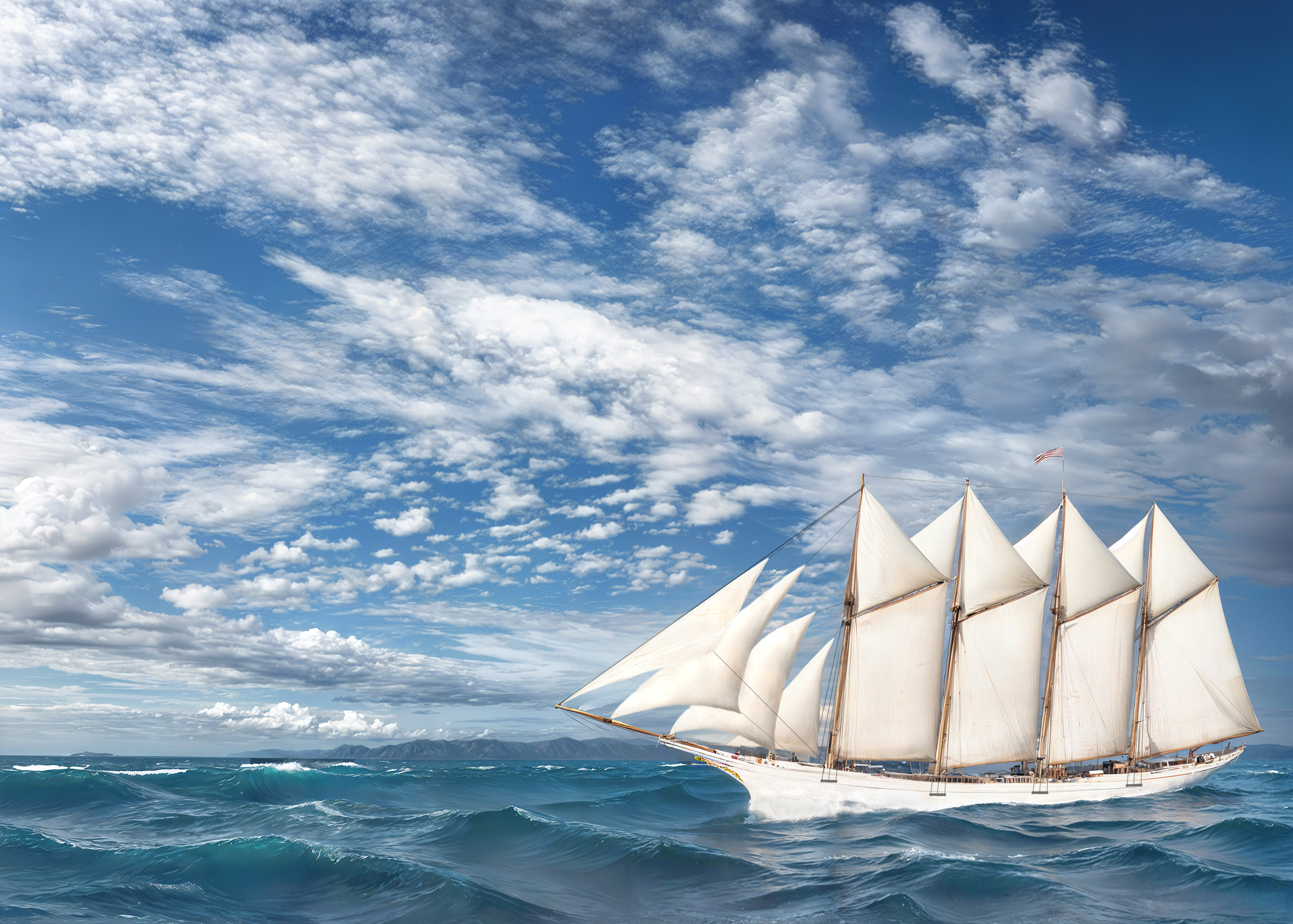
Marie Palmer
2025
Marie Palmer was part of the Great White Fleet of William F. Palmer. So called because the fleet were painted white. The ships Marie and Maud were 4-masted and the remaining 5-masted.
Marie was William F. Palmer’s wife and his first foray into shipping as an owner, vessel designer, construction supervisor, operations manager of the fleet and financier. All of which he did from his personal residence in Dorchester Massachusetts.
Bristol Academy at Taunton, Massachusetts, for eight years during the ’90’s. His nautical interests began to take form while he was at Taunton where he mastered the study of naval architecture. Taunton was the hub of the New England bituminous trade at that time.
Much is made of the fact that WFP increased his fleet to geometric proportions in the ten years before he died at age 50. Fifteen is the number used. The hulls are number one thru sixteen. Hull number thirteen was never issued - Fannie I was abandoned in 1906 and replaced with Fannie II in 1907. There were only 14 in the fleet at any one time.

Wyoming
2024
Wyoming was a wooden six-masted schooner completed in 1909 by the firm of Percy & Small in Bath, Maine. With a length of 450 ft from jib-boom tip to spanker boom tip, Wyoming was the largest known wooden ship ever built.
The "Wyoming" was the tenth and last of the six-masters.
In March 1924 she sailed from Norfolk, Virginia for Saint John, New Brunswick, with a cargo of coal. On March 11, to ride out a nor'easter, she anchored near the Pollock Rip Lightship off Monomoy Island Chatham, Massachusetts. She and her crew of 14 were lost when the ship broke up in the storm.